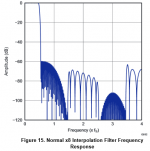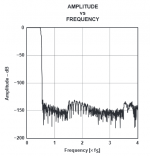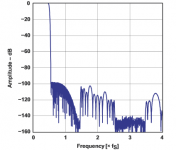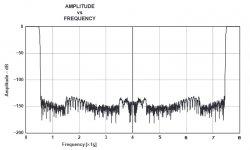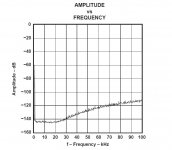RNM
My quickly calcs give me a source impedance of 2 ohms just from anticpated trace length based on reading 50 mV at 3 MHz for the cross talk. So if you are dropping the noise a bit with an external 600 resistor just a bit that would rule out simple coupling. There might be another reason for the cross talk.
Getting interesting. I suspect it is a stereo A/D and the issue may be in the chip.
My quickly calcs give me a source impedance of 2 ohms just from anticpated trace length based on reading 50 mV at 3 MHz for the cross talk. So if you are dropping the noise a bit with an external 600 resistor just a bit that would rule out simple coupling. There might be another reason for the cross talk.
Getting interesting. I suspect it is a stereo A/D and the issue may be in the chip.
I checked the freq of the higher level channel input... the freq is 1-3MHz centered at about 2.8MHz. Even if this is needed for the design/chip..... what does that do to the source when it sees 2.8MHz at .7 volt level? Maybe nothing... maybe something. dc offset, increased noise and/or increased distortion from source. Even if it cant be amplified efficiently.
It is one thing to try to understand the design.... but, I just want to make it all work the best it can together with analog. Not redesign it. or else get something else.
THx-RNMarsh
It is one thing to try to understand the design.... but, I just want to make it all work the best it can together with analog. Not redesign it. or else get something else.
THx-RNMarsh
Last edited:
There would be damping by the output impedance of the source. But at that frequency opamps would have little gain margin so I would expect to see a source impedance around 100 ohms.
So I would expect a seeming increase in noise level and even some birdies.
Of course in my systems I like transformers. But the scale is a bit larger. I suspect an experiment with bifilar noise filters may be in order. Of course no matter what you hear the true believers will tell you are imaging it. So enjoy the "illusions."
So I would expect a seeming increase in noise level and even some birdies.
Of course in my systems I like transformers. But the scale is a bit larger. I suspect an experiment with bifilar noise filters may be in order. Of course no matter what you hear the true believers will tell you are imaging it. So enjoy the "illusions."
Last edited:
wrt DACs: it's pretty much a matter of getting what you're paying for. The datasheets make no mystery of the HF noise.
PCM5102 (cheap)
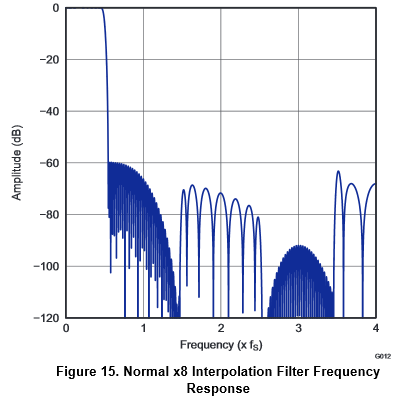
PCM1798 (middle of the road)
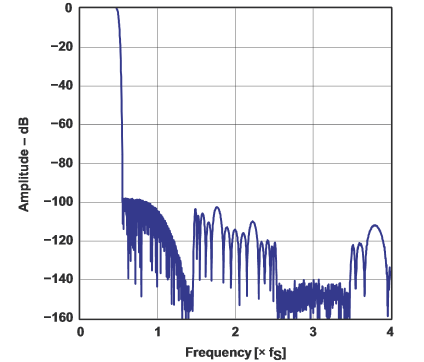
PCM1794 (best)
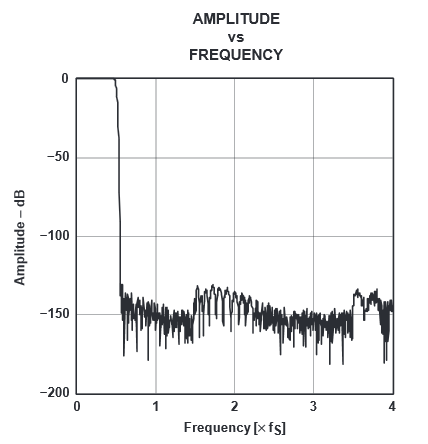
wrt ADC: you clearly have boatloads of noise. Before jumping to conclusions, it would be interesting to identify the source of that noise. Only you can do it, it might be specific to your setup.
PCM5102 (cheap)
PCM1798 (middle of the road)
PCM1794 (best)
wrt ADC: you clearly have boatloads of noise. Before jumping to conclusions, it would be interesting to identify the source of that noise. Only you can do it, it might be specific to your setup.
Attachments
It seems that only the most expensive and with well designed support circuitry etal produces what you would expect to see in practice. I have the best spec numbers ADC and DAC around (BenchMark's newest).
But, for CD players and even a mastering CD unit such as what I am measuring here (Elesis MasterLink ML-9600) it is not an exception nor unique to my setup .... as I said before I also find this kind of HF junk on analog output of a new and not cheap DVD (HD/3D) player. I'll check others... maybe I'll get a new OPPO and see what it does on its analog in-outputs. But for most average Joe out there who bought a 'good to better' level CD player they might not like the sound they get due to stuff like what I am measuring and what affect it has on analog pre/PA/Speakers with its' further amplification.
What brand and model CD player uses the PCM1794?
THx-RNMarsh
But, for CD players and even a mastering CD unit such as what I am measuring here (Elesis MasterLink ML-9600) it is not an exception nor unique to my setup .... as I said before I also find this kind of HF junk on analog output of a new and not cheap DVD (HD/3D) player. I'll check others... maybe I'll get a new OPPO and see what it does on its analog in-outputs. But for most average Joe out there who bought a 'good to better' level CD player they might not like the sound they get due to stuff like what I am measuring and what affect it has on analog pre/PA/Speakers with its' further amplification.
What brand and model CD player uses the PCM1794?
THx-RNMarsh
Last edited:
The thing I don't get is that, whilst for a sellable unit you have to handle all possibilities, here in DIY land where you have control over the signal path, why less discussion on bandwidth limiting in the preamp, where its a lot easier to do a higher order filter?
And this is said from a poacher turned gamekeeper!
And this is said from a poacher turned gamekeeper!
Bill--if it's a digital source, why wouldn't you bandwidth limit as close to the DAC output as possible? A mm/mc preamp should likewise condition its signal to play nice with subsequent stages.
Then you're left with filters to minimize noise ingress. But, really, I fail to see the relevance of a preamp, unless you're using the term for a input selection box with a buffered attenuator. We already have too much gain from end-to-end as it stands.
Then you're left with filters to minimize noise ingress. But, really, I fail to see the relevance of a preamp, unless you're using the term for a input selection box with a buffered attenuator. We already have too much gain from end-to-end as it stands.
I mean signal conditioning between source and power amplifier. positive gain is optional. Although personally as I get older I am tending more towards trying to run pre-power amp runs at pro levels. It makes more sense to be balanced and high level even if its not necessarily needed for home use.
What brand and model CD player uses the PCM1794?
THx-RNMarsh
The complete d/a DAC converter list - DutchAudioClassics.nl
Fred and Bill,
I think I am of the same mind as the two of you. While I don't see much of any reason to need a preamp these days with the voltage output from a CD player or many other digital devices what I truly want is an active tone control between the devices and the power amp. There is just no way that I am going to use the same settings at low volume as when the music is cranked up. There is no way around the Fletcher Munson curves, our ears sensitivity changes so much with level that I just don't see why there is such a disdain for some form of tone control, whether something very simple or a basic parametric eq. I can easily run a CDP direct to a great power amp and great speakers but I still want some way to shape the curve for the level that I am listening to at the moment.
I think I am of the same mind as the two of you. While I don't see much of any reason to need a preamp these days with the voltage output from a CD player or many other digital devices what I truly want is an active tone control between the devices and the power amp. There is just no way that I am going to use the same settings at low volume as when the music is cranked up. There is no way around the Fletcher Munson curves, our ears sensitivity changes so much with level that I just don't see why there is such a disdain for some form of tone control, whether something very simple or a basic parametric eq. I can easily run a CDP direct to a great power amp and great speakers but I still want some way to shape the curve for the level that I am listening to at the moment.
Richard, everybody,
Taking everything said into account, could I surmise that it would be recommended to use a buffered CD input line to the premap/amp, where the buffer would also act as a low pass second order filter at around 44.1 (50) kHz to avoid appearently very possible problems with HF junk leaking in?
Taking everything said into account, could I surmise that it would be recommended to use a buffered CD input line to the premap/amp, where the buffer would also act as a low pass second order filter at around 44.1 (50) kHz to avoid appearently very possible problems with HF junk leaking in?
Very nice reference. But with all the data you have found and measured it begs the question, do you have a life?
Thanks again.
Fred and Bill,
I think I am of the same mind as the two of you. While I don't see much of any reason to need a preamp these days with the voltage output from a CD player or many other digital devices what I truly want is an active tone control between the devices and the power amp. There is just no way that I am going to use the same settings at low volume as when the music is cranked up. There is no way around the Fletcher Munson curves, our ears sensitivity changes so much with level that I just don't see why there is such a disdain for some form of tone control, whether something very simple or a basic parametric eq. I can easily run a CDP direct to a great power amp and great speakers but I still want some way to shape the curve for the level that I am listening to at the moment.

wrt DACs: it's pretty much a matter of getting what you're paying for. The datasheets make no mystery of the HF noise.
PCM5102 (cheap)
PCM1798 (middle of the road)
PCM1794 (best)
These graphs show only internal (to the DAC) oversampling digital filter stop-band performance in digital domain. And only up to the 4x Fs (!) They do not show what happens at 8xFs or what comes out of D/A portion of the chips.
The real situation is more like this. First image is manipulated by me, the second one is from the last page of the PCM1794 data sheet. Note the signal amplitude at 8x Fs in the first one and raising noise floor in the second that looks just like in Richard's measurements.
Attachments
These graphs show only internal (to the DAC) oversampling digital filter stop-band performance in digital domain. And only up to the 4x Fs (!) They do not show what happens at 8xFs or what comes out of D/A portion of the chips.
The real situation is more like this. First image is manipulated by me, the second one is from the last page of the PCM1794 data sheet. Note the signal amplitude at 8x Fs in the first one and raising noise floor in the second that looks just like in Richard's measurements.
The real situation is that you also have an analog filter after the DAC. See the datasheets for a typical implementation.
At 8xFs, even a mild analog filter will counteract the rising HF noise.
edit: and if you're worried about the -110dB noise floor at 100Khz, it's easy enough to implement a more stringent lpf.
Last edited:
considerations for the analog post-filters
Wading into this with some reluctance --- one aspect that may have been under-discussed is the propensity of particular active electronics to have nonlinearities that allow the detection and intermodulation of out-of-band signals. One expects these effects to be small when the out-of-band peak signals are small. But some devices are better than others in general, with it having been observed for a long time that bipolar front ends are more sensitive to such effects than JFETs (or tubes). Richer biasing and wider open-loop bandwidths will help all, provided that closed-loop stability is maintained, but especially for bipolars. And filter topologies that may have been optimized for low in-band noise may not be optimal for avoiding high frequency effects.
Again, with things down as far as they tend to be to begin with, the effects should be small. It would be interesting to see a truly broadband spectrum for some of the DACs, and perhaps a histogram of peak voltages.
Wading into this with some reluctance --- one aspect that may have been under-discussed is the propensity of particular active electronics to have nonlinearities that allow the detection and intermodulation of out-of-band signals. One expects these effects to be small when the out-of-band peak signals are small. But some devices are better than others in general, with it having been observed for a long time that bipolar front ends are more sensitive to such effects than JFETs (or tubes). Richer biasing and wider open-loop bandwidths will help all, provided that closed-loop stability is maintained, but especially for bipolars. And filter topologies that may have been optimized for low in-band noise may not be optimal for avoiding high frequency effects.
Again, with things down as far as they tend to be to begin with, the effects should be small. It would be interesting to see a truly broadband spectrum for some of the DACs, and perhaps a histogram of peak voltages.
- Status
- Not open for further replies.
- Home
- Member Areas
- The Lounge
- John Curl's Blowtorch preamplifier part II
